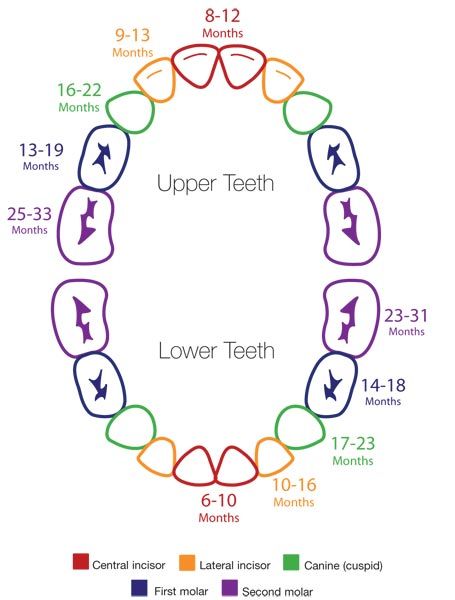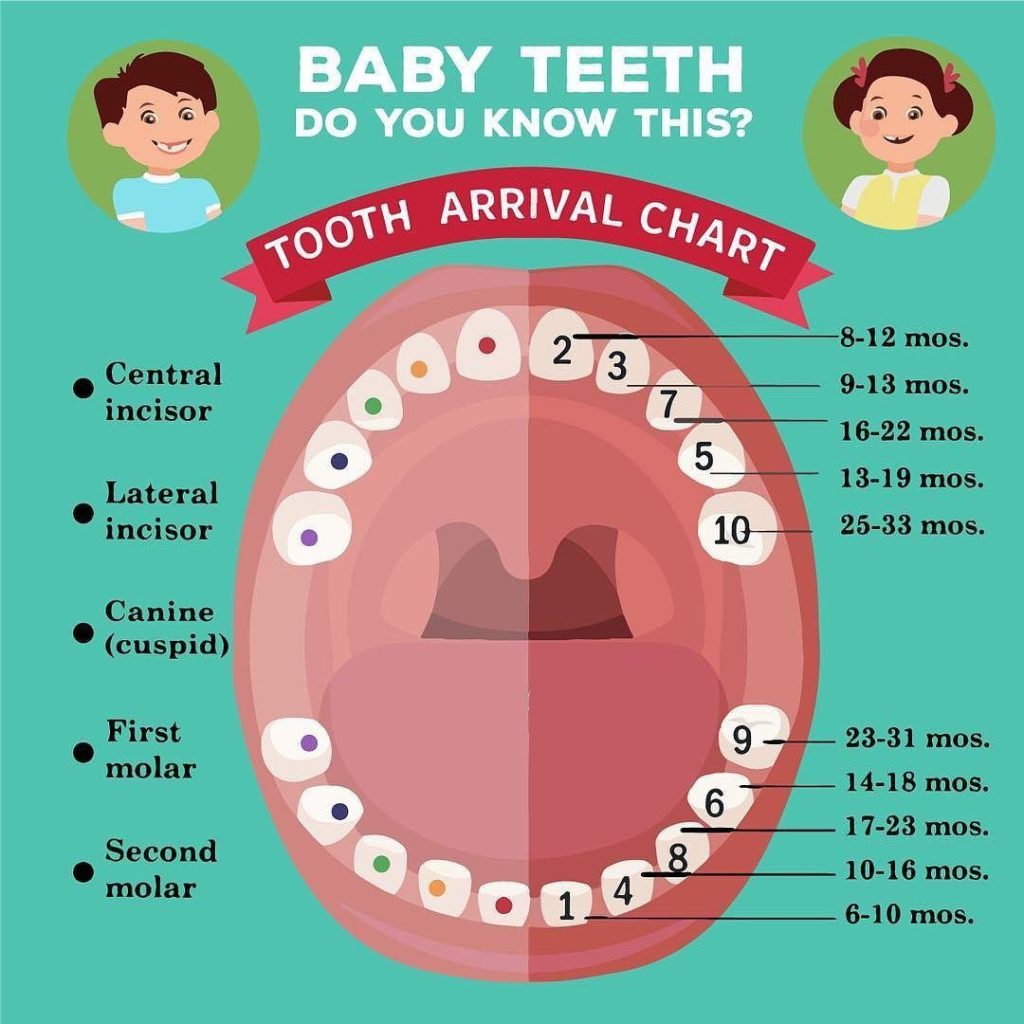During the first months of life, significant changes in the development of baby continuously occur, not only in terms of growth and body weight (physical development), but also in mental, motor, emotional, speech, and social development. One of the main indicators of a child’s health and the most important stage of development of the maxillofacial region is the process of teething. During this period, parents have a huge number of questions that they turn to the pediatrician or try to figure out on their own using the Internet and the experience of friends and relatives. The article is devoted to topical issues of teething, which are often asked by worried parents when visiting a child’s doctor.
Development of teeth in babies
The development and further teething is a rather complex process, carried out under the control of the nervous and endocrine systems. The laying and formation of temporary (milk) teeth begins already at the 6–8th week of pregnancy, and at the end of the 4th month of embryonic life, histogenesis of the hard tissues of the tooth occurs. First, dentin is formed, then enamel. Calcification of tissues begins at the end of the 5th month of embryonic development. In the prenatal period, the laying and development of permanent teeth (incisors, canines, small molars) is also carried out, starting from the 5th month. When teething, differentiation of tooth tissues occurs, which is accompanied by an increase in volume and the creation of an embryo of pressure inside. Bone tissue is rearranged in front and behind the anlage, which, if there is tension inside the anlage, causes its movement.
baby teething top teeth
Milk teeth usually begin to erupt at the age of 6 months to 2.5 years in a strictly defined sequence. At the age of 6–9 months, the child begins to erupt the first teeth in the very center of the lower jaw – the central lower incisors. They are followed by milk central incisors on the upper jaw. Duration of teething: 7-10 months. Lateral incisors on the lower and upper jaws appear at the age of 9-12 months. Usually, by the first year of life, a child should normally have 8 teeth, and the presence of 2–4 or 10 teeth at this age is not a serious deviation. The first milk molars on both jaws appear at the age of 13-19 months. At sixteen months, a canine begins to erupt in the gap between the molars and the lateral incisors. Second chewing teeth on the lower and then on the upper jaw erupt last. A complete set of 20 milk teeth should be formed by three years.
Is it possible to shift the terms of teething during normal development of the child and why it depends
The timing of teething in a particular healthy child may depend on genetic factors: that is, on how they erupted in parents and even in grandparents. Secondly, from various environmental factors (climatic conditions, the nature of nutrition, the quality of drinking water, etc.). Violation of the terms of teething can be caused by the presence of rickets in the child – in this case it is necessary to prescribe vitamins or calcium preparations to maintain normal mineral metabolism.
As already mentioned, the complete formation of the milk dentition usually ends by three years, but in recent years, earlier periods of eruption of milk teeth have been noted. The teething process begins at 4 months, and ends at 2 years. However, sometimes in completely healthy children, later teething times are observed: teething starts at 8–10 months, and ends at 3–5 years. It was noted that in children of elderly parents the teeth erupt somewhat earlier than in children of young parents. In the first-born, the teeth begin to erupt earlier than in the second and third children.
Late teething in baby
In order to accelerate teething, parents can be advised to buy special ring toys – teething stimulants. It is useful to do a light massage of the gums with a clean finger, because pressure on the gums facilitates and speeds up teething, and cold reduces unpleasant sensations. In rare cases, adentia, the absence of tooth primordia, can be detected in children. If the child is already more than a year old, and his teeth have not yet begun to erupt, you need to send him for a consultation with a dentist. In such cases, the presence of dental rudiments is checked using an X-ray or radiovisiograph, which is safer.

Teething symptoms in infants
To miss the moment when the child has the first teeth is quite difficult. Teething symptoms may include redness, gum disease, and possibly a swollen “white ball” from which a tooth is about to emerge. Teething is preceded by profuse salivation. A particularly sharp increase in the amount of saliva to be separated is observed between the 5th and 7th months. This is to some extent associated with mechanical irritation of the sensitive nerves of the gums, preparing for teething. Its leakage from the oral cavity is explained by the lack of the child’s ability to regulate the amount of saliva in the mouth and the insignificant depth of the oral cavity. Gradually, a reflex is developed to regulate the amount of saliva in the mouth by swallowing it; when teething subsequent teeth, salivation is less pronounced.
Signs of physiological teething are: teething at certain average times; pairing of teething; teething in a certain order.
However, teething can be accompanied, for example, by increased irritability: the child becomes restless, moody, cries at night, refuses to eat; but at the same time takes any object into the mouth, because chewing reduces the itching in the gums. At the same time, salivation is increased, which can cause skin irritation in the mouth. Body temperature can rise to subfebrile (within 37.8 °). However, fever does not necessarily accompany teething. So, a slight weakening of immunity during teething creates favorable conditions for the attachment of a secondary infection, which is manifested by nausea, vomiting, earache, diarrhea, cough, rash, febrile values of body temperature. These symptoms should be an occasion for parents to see a doctor.
How to help with teething
The simplest remedy is cold, which relieves pain and reduces swelling. In pharmacies, special teethers filled with water are presented. Before giving the child, they are cooled in the refrigerator. Parents should know: you can’t freeze teethers; they can crack and damage the gums. A cool teether will have an analgesic effect, and its tuberous surface will have a gum massage effect. If the cold does not help, you can recommend a dental gel containing anti-inflammatory and painkillers to lubricate the gums. With severe pain, you can prescribe an anesthetic to the child. Specialized tooth gels of various compositions with anesthetics and antiseptics are used. Dental adhesive pastes (for external use – do not confuse), which have reparative properties, are useful in the presence of bleeding wounds or painful sores.
Parents should be reminded of strict adherence to the recommended rules of admission, especially the frequency of use. The local anesthetic contained in the gel during uncontrolled use can contribute to a reduction in heart rate. Almost all gels contain lidocaine and inert fillers (menthol for cooling, flavors and astringents). Therefore, when using monopreparations and combined medicines, including anesthetics, antiseptics, etc., the development of allergic reactions of varying severity is possible. Gels with sweet flavors are limited for use in children with diathesis. An important feature of this group of drugs is age restrictions. Some drugs can be used from 3 months, others from 5-6 months. At the same time, the use of gels with anesthetics is limited by the unidirectional effect, helps to cope with pain, but does not solve the problem of leveling the entire complex of unpleasant, sometimes quite intense symptoms that occur when teething.
What else should I definitely recommend to parents of children who have baby teeth
Parents should be strongly advised to observe the rules of hygiene of the child’s oral cavity:
– it is necessary to regularly wipe the baby’s face with a special towel to remove saliva and prevent irritation on the skin,
– gently soak the saliva, avoiding rough friction (soft towel, napkin), so as not to cause irritation around the mouth,
– It is recommended to give the child something to nibble. Special teething rings, which are sold in pharmacies, also help to alleviate the condition of the baby. But you can’t tie a teething ring to the child’s neck so that he doesn’t get entangled in the tape,
– during teething, it is necessary to observe the highest possible level of oral hygiene in order to avoid the attachment of a secondary infection,
– it is important to remember that with the appearance of teeth, it is necessary to prevent caries, because immediately after eruption, the teeth are exposed to aggressive environmental influences. Microbes settle on them, plaque is formed, in which acids are actively produced. Under their influence, the enamel of milk teeth is easily destroyed and a carious cavity is formed. The production of acid is especially active in the presence of sugar. Therefore, the cause of caries in the first years of life often becomes an early transition to artificial feeding, especially if the child sucks milk formulas or juices from a bottle with a pacifier for a long time,
– Parents should not lick the pacifier and try the baby’s food with a baby spoon. So you can protect the baby’s mouth from bacteria that are in the saliva of an adult,
– if possible, it is necessary to reduce the sugar content in the children’s diet, give water or natural juice instead of sweetened drinks and never give sweet drink as a “sleeping pill”,
– you should teach a one-year-old baby to drink a few sips of water after eating, and after two years to rinse his mouth after eating,
– it is important to teach a child to brush his teeth after each meal or at least twice a day, including always before bedtime.
You may also be interested in such topics:
